► Land Rover Defender group test
► The new 4×4 vs some old rivals
► Good enough to see of the G and Jeep?
We know the new Defender is good, but how good? Land Rover’s modernised icon goes into battle against the old-school benchmarks, Merc’s G and Jeep’s Wrangler.
Land Rover Defender: pre-flight briefing
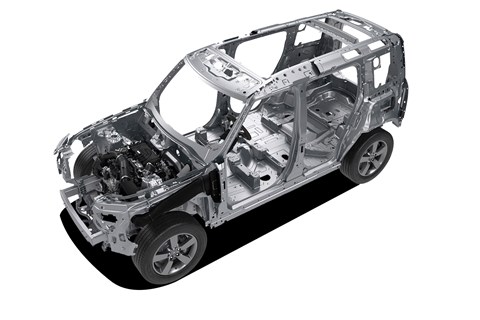
Why is it here?
The car that created the company in 1948 ended up as the odd man out by the time its run ended in 2016. If the old Defender (the name used from 1990) was still true to the frontier spirit of the Series I, II and III that preceded it, it had been left behind by the rivals it inspired – and by the rest of the Land Rover line-up. With the 2020 Defender, Land Rover puts that right, taking the 1948 car as inspiration but creating a thoroughly modern car in its image.
Any clever stuff?
Out goes the body-on-frame chassis with its crude suspension, in comes a version of the D7 aluminium monocoque also found in the Range Rover. There’s fully independent suspension, with air springs on some models, new engines and JLR’s most advanced infotainment.
Which version is this?
Made in Slovakia, the new Defender is available in two lengths, 90 (soon) and 110 (now), and with a choice of two diesel fours, a four-cylinder petrol and a six-cylinder mild-hybrid petrol. A V8 has been spied testing. A commercial version has also been launched, dubbed Hard Top although, despite its name, it does not have a removable roof.
Read our Land Rover Defender review
Jeep Wrangler: pre-flight briefing
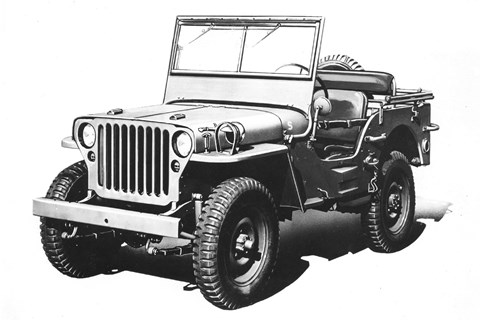
Why is it here?
The Wrangler may look like a Second World War Jeep but the Wrangler name wasn’t introduced until 1986, and it’s never claimed any ’40s DNA – but certainly the spirit of simplicity, versatility and ruggedness is the same. Like the Defender and G-Class, today’s Wrangler still has genuinely phenomenal off-road ability (in the right hands, on the right tyres), but only a minority of buyers ever exploit that, instead buying into a lifestyle.
Any clever stuff?
Now in its fourth generation, the Wrangler sticks with old (sorry, tried and trusted) technology: separate body and frame, rigid live axles, and some versions feature such feelgood features as fold-flat windscreen and detachable doors.
Which version is this?
The UK doesn’t get the whole Wrangler line-up, but there’s still plenty of choice. You can have two or four doors, fixed or detachable roof, and a choice of petrol or diesel engines. Our Overland is a relatively sensible, well equipped all-rounder, with a roof and a vast optional sunroof big enough to climb out of should you need.
Read our Jeep Wrangler review
Mercedes G-Class: pre-flight briefing
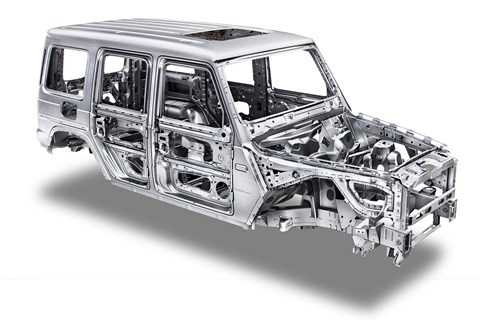
Why is it here?
A storied Merc that doesn’t have any awkward Nazi-related skeletons in its closet? Hurrah! Except the G-Class has something else in its origin story that Mercedes would rather not go on about. It originally came into being, at least in part, because the Shah of Iran – a shareholder – wanted a tough army truck. That eventually emerged as 1979’s original G, just in time for the Shah to be deposed and the order cancelled. Over the last 40 years it’s proven itself on safari and in desert races, sprouted an official Mercedes three-axle version, the G63 6×6, been a Popemobile, had the Maybach treatment and gone wild in 2004 with the 470bhp G55 V8.
Any clever stuff?
Always a bigger deal in Germany than elsewhere, it’s only with this latest version that Mercedes has made a serious attempt to treat it as an integral part of its global line-up, the head of the SUV range. Its price reflects the fact that it’s hand-built, by Steyr in Graz. The G-Class stopped evolving and took a significant technological step forward for 2018, gaining modern infotainment, a new alloy body and a new chassis, albeit still a ladder frame.
Which version is this?
In the UK we only get two models, the G350d in AMG Line trim and the AMG G63. Elsewhere there’s the G400, with a hotter version of the same six-cylinder diesel, and a G580 V8 is on its way.
Read our Mercedes G-Class review
Defender vs Wrangler vs G-Class: the test
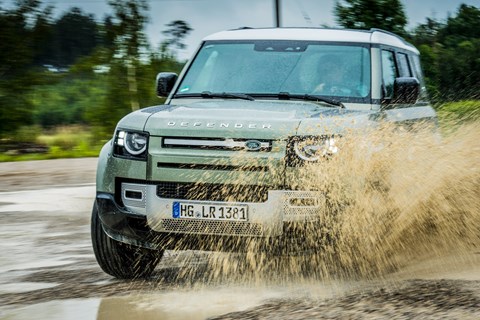
Oh yes. On the road, the 2020 Defender does everything the previous vintage refused to even try to do. Like run straight and true and smooth, irrespective of surface. Like steer without random surprises. Like accept a stab at the brake pedal as an order, rather than a polite request to be dealt with in good time. Like relishing towns, motorways and country lanes just as much as it enjoys crossing a mountain range. And all without deafening the occupants above 50mph.
The latest Land Rover is a dynamic revelation. It rides at least as smoothly over most surfaces as today’s key rivals, the Mercedes G-Class and Jeep Wrangler. The brakes are reassuringly strong. Directional stability is no longer a theoretical target but an accomplished mission.
Without mastering those absolute essentials, the long-awaited, hotly debated Defender would be no more than a marketing tool, a design exercise… an irrelevance. But take it from me, this drives like no Defender before it, while retaining the legendary ruggedness and off-road ability.
Just as well, since it arrives at a time when serious questions are being asked of Jaguar Land Rover as a business, particularly Jaguar, and some very promising newcomers are getting ready to join the fray, from the Ford Bronco to the Ineos Grenadier. A sub-standard product now would wilt into insignificance.
Historically, these three SUVs started life as rudimentary off-roaders driven by customer needs rather than by lifestyle-obsessed marketing gurus. Great in one particular area, they were hopelessly outclassed in other disciplines like ride comfort and active safety. In some cases, it took decades for these yawning talent gaps to narrow, but in their latest guise the Jeep, the monolithic Merc and the reinvented Landie are stand-out all-rounders in terms of competence and desirability.
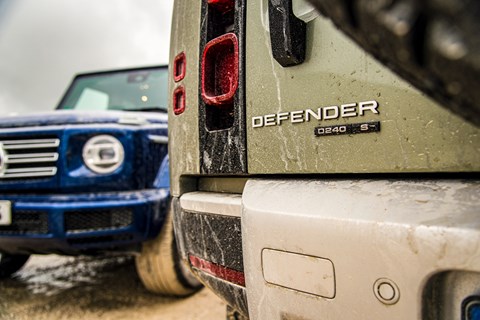
In our fast-moving, high-tech environment, the previous Defender was a standalone fetish for real men who lived on quarter-pound Cuban cigars, indulged in the great outdoors with rare passion… or at least liked to let people draw those conclusions from their Defender’s battle scars. The 2020 replacement offers plenty of retro touches yet is a totally contemporary piece of kit. It’s available with a wide range of mod cons, built to the latest safety standards and no longer drives like a ponderous sluggard. And in our test car’s longer 110 form it’s roomy, too, with the option of a third row of seats.
Under the skin it’s now more closely related to the Discovery, Range Rover and Range Rover Sport – all of them, to different degrees, very good on road and off. The Defender First Edition comes with both off-road packs (Terrain Response 2 and Configurable Terrain Response), ensuring it’s ready for just about anything. Our test car is the 240 diesel, making 237bhp and a very healthy 317lb ft.
Unlike the Jeep and Merc, the Defender 110 is spaciously laid out, airy, tastefully appointed and garnished with zeitgeist-meets-vintage touches. The driving position is at long last spot-on, the cabin layout oozes coolness and modernity and the trim ranges from planet-friendly fabrics to a Range Rover-inspired world of leather.
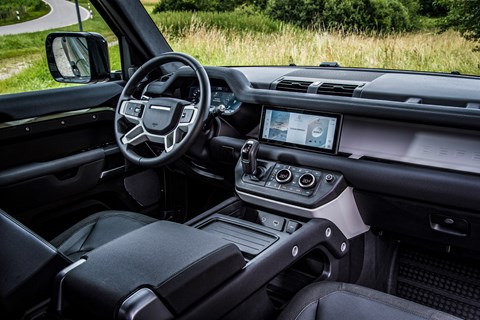
The basic controls are self-explanatory, and the infotainment is largely intuitive and angst-free, but things can get complicated once you start exploring the numerous Terrain Response trickeries. The most useful novelty in this department is ClearSight Ground View; several cameras working in concert to render your ordinarily obstructive bonnet invisible. It’s a supremely handy feature off-road and on it.
Another welcome goodie is the Configurable Terrain Response, which lets you lock the centre diff, deactivate ESP, adjust the torque bias, dial in on-the-fly low-range gearing, vary hill-descent velocity and tweak traction control.
Technologically, the Wrangler is at the other end of the spectrum. It still uses a box-section ladder frame made of steel as well as live cast-iron axles front and rear. While the Rubicon model boasts additional diff locks, a front anti-roll bar which can be disconnected for enhanced articulation and a more radical Rock-Trac all-wheel-drive system, the Overland is a less dedicated if still highly capable mud-crawler.
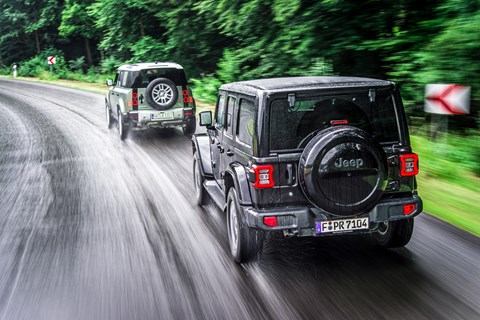
Like the G-Class, the Wrangler feels narrow and cramped for a big car, the centre console and fat transmission tunnel taking up too much space, the interior radiating the dim charm of a defunct coal mine. While the new Defender passes the aero test with flying colours (its drag coefficient is down from 0.68 to 0.38), its two-box rivals keep on punching the headwind in the face, devour more insects per mile than a 747 during take-off, and sometimes make you feel more confined than cocooned.
The Jeep is an increasingly rare delight for lovers of knobs, buttons and switches; it shoulders the encased spare as proudly as the other two; and if need be, its rubber-tiled floor can, like that of the Defender, be cleaned with a hose.
Merc’s 2018 reinvention of the G-Class stayed close to the traditional look, but the whole package was extensively re-engineered. It gained independent front suspension, borrowed from the S-Class the much more advanced electronic architecture, gained a little width and length, underwent subtle styling changes and shed 170kg thanks to the extensive substitution of materials. Although the upgraded driver environment is a class act all round, you pay handsomely for the pleasure. Fit and finish are flawless, but the doors must be slammed shut, the occupants sit far too close to the side windows, the flush opening latches are difficult to grab and, while headroom abounds, tall occupants could do with more legroom. The infotainment is not the latest MBUX equipment, but makes good use of the Comand controller and touchscreen.
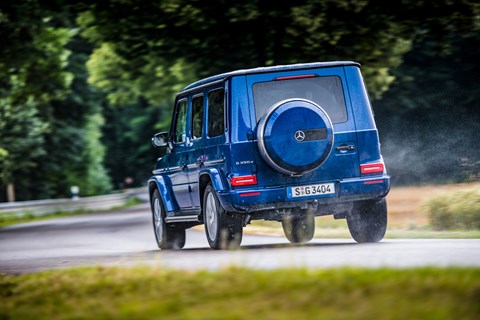
These are all big cars, at least by European standards. The key to having fun is to maintain the flow at all times and avoid unnecessary braking, as getting all that weight back up to speed takes time. They all have eight-speed automatic transmissions to help you ride the torque. In the case of the Land Rover, you don’t get shift paddles to help keep the 237bhp 2.0-litre unit in the zone. The figures are okay – 9.1sec to 0-62mph and a top speed of 117mph – but the Ingenium engine has to work hard to deliver them and, deployed in this way, it’s a near-total failure for NVH (noise, vibration and harshness). But the rest of the time, the Defender benefits from being the only vehicle of this threesome which has been developed from scratch. It is modern by design, not by retrofitting current modules to an ancient base. Admittedly, a large portion of its appeal is due to the huge improvement over the rudimentary predecessor.
Another key decider in its favour is design, inside and out. Gerry McGovern’s team has done a splendid job re-imagining a true classic without hanging on to idiosyncrasies like that millpond-flat windscreen, slabby doors and stone-age fittings. The challenger from the Midlands excels in terms of space utilisation, aerodynamic efficiency and laid-back practicality. While the Wrangler slows down momentarily as it passes Memory Lane, and the Mercedes comes to a brief halt, the Defender sails through without even pondering where it came from, its sat-nav firmly set on destination future.
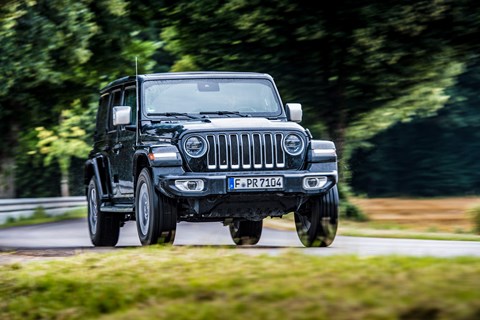
The Jeep’s 2143cc 197bhp diesel hits the drag wall at 112mph but it beats the Defender by two tenths on the acceleration run, thanks to its generous torque and relatively low weight. And where the Land Rover’s turning circle is an unwieldy 12.8 metres, and the G-Class requires an even clumsier 13.5 metres, the Jeep manages a 12.3-metre radius. How on earth did we do it before all those cameras and sensors came on board?
The Jeep, in Overland spec, has three four-wheel-drive settings (High, Low and Auto) and two-wheel-drive High, typically ignored by the off-road fraternity, but a blast for on-road hooligans. It sends up to 332lb ft to the rear wheels only, opens all the diff locks and encourages the undivided rear axle to cut loose whenever you boot the throttle. In the pouring rain, involuntary snap oversteer at 50mph is not uncommon even with ESP fully active, nor are on-demand second-gear slides through tight corners and spectacular starts to the traffic-light drag race.
It would be even more rewarding if the steering acted more quickly and was less prone to growing heavy early. Left in four-wheel-drive Auto, the Wrangler swaps the lairy handling for a balanced mix of keen turn-in, mediocre grip and the swift restoration of a largely neutral, almost defensive cornering attitude.
The Jeep is let down by a generally poor ride, aerodynamic inefficiency and the low-rent feel of the cabin. The dashboard is an ergonomic afterthought, and after a couple of hours there comes a time when you realise your ears are numb and your back hurts. On the credit side, hats off to one of the largest optional sunroofs currently on the market (the £2200 Sky One-Touch Power Top), the heart-warming sense of general indestructibility and that non-conformist urban guerilla message. It’s not a car that makes a lot of sense for many people. But as a way of living out a specific dream, there’s no denying it can be a lot of fun.
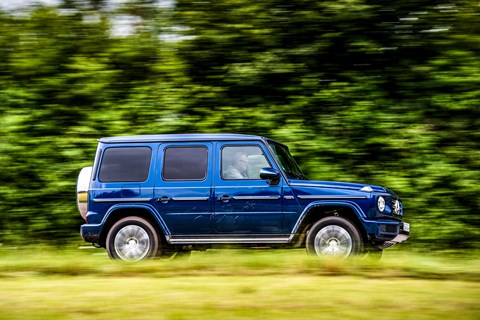
The Mercedes has some impressive numbers. Two extra cylinders. Highest top speed (124mph). Lowest 0-62mph time (7.4sec). Highest price. The big, boxy Benz is not only a statement of affluence, it’s also a luxuriously kitted-out mobile fortress, the perfect car to be in the day the world grinds to halt and the final curtain drops. While the AMG G63 is an object lesson in overkill, the G350d strikes more of a balance between style and solidity, appeal and ability (see page 120 for more).
It may be wasted in town and on the highway, but as soon as the going gets tough the G shows what it can do. The bad news starts with the somewhat stodgy handling, which doesn’t rise above the inevitable effects of combining a considerable mass and an elevated centre of gravity. The 350d in particular is furthermore handicapped by a distinct nose-heaviness which is – together with the suspicious wet grip – to blame for early and eventually terminal understeer.
Other irritations on the Merc include the odd kickback from the rear axle under hard acceleration, even on the smoothest of roads, excessive bodyroll, a certain haptic tranquilliser effect when you wind on a bit too much lock, and powerful but uncomfortably heavy brakes.
We had the cars for five days, of which one was spent mostly off road, although only about five per cent of our total test mileage was accrued on that day, such is the stop-start nature of off-roading.

Locking the centre diff makes all three gravel-greedy hotshoes more tail-happy, locking the rear diff improves grip and traction, locking the front diff (not possible in the Defender) anaesthetises the steering for the sake of ultimate off-road ability. Deactivating stability control is in all cases liable to unhinge more mass and greater force than is advisable for making it safely through to the exit of the corner. We did not spend enough time in the dirt to establish a firm off-road ranking, but rest assured that all three are at least as competent on challenging surfaces as you are, and better than anyone needs them to be.
On-road, the Jeep and Mercedes must pay the price for hanging on to ancient engineering concepts. The G is a grand cruiser which covers miles with the same professionalism with which it masters the steepest gradients, the deepest fords and the most cruel rock formations. Its 40:60 front-to-rear torque split should make it more agile through the twisties, where the in-fight between weight vectoring, steering angle and torque feed tends to blur the plotted course by adding a degree of indifference which only goes away when the driver backs off. If you’re actually going to do some serious off-roading and you insist on a Merc, the G could well be the right car for you. But otherwise, the more family-, road- and wallet-friendly GLS and GLE are both better SUVs.
If our time with these three behemoths was at all typical, it’s worth reporting that the public is increasingly suspicious of two-tonne-plus SUVs whose prime mission appears to be bolstering owners’ egos.
The G-Class seemed to be subject to the same negativity affecting many of the more overtly expensive Mercs. The Wrangler, by contrast, provoked as much amusement as hostility. The new Defender – the first that most people had seen – was met with a mix of interest, curiosity, scepticism and approval. It’s big and does look heavy, but the design was perceived as friendly among onlookers we spoke to.
The problem the 4x4s all faced was the fourth question many people asked. After ‘how much?’, ‘how powerful?’ and ‘how fast?’, most wanted to examine them in search of serious hybridisation and electrification, which, is only just starting to take shape (there’s a recently-announced PHEV Defender P400e and an incoming PHEV Wrangler 4xe). Upon closer study, however, the energy consumption is no real reason to black-flag any of the diesel-fed entrants. True, the G350d is not exactly a fuel miser at an observed 20.7mpg, but the Wrangler did okay at 25.6mpg, and the D240 averaged 26.8mpg – one of many examples where the clean-sheet design works to its advantage. True, a pure battery-electric powertrain would be at odds with these car’ spirit of rugged individualism – finding a charger in St Albans is difficult enough, let alone the Sahara – but how long can they afford to be slow to act to the soaring interest in plugging in?
Defender vs Wrangler vs G-Class: the final reckoning
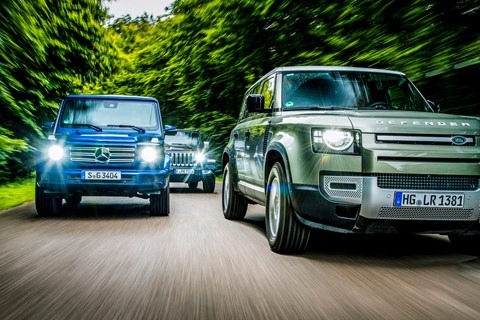
The new Defender is everything the old Defender wasn’t. Most importantly, it is at long last fun to drive, and unexpectedly comfortable. Cementing the victory are the centrefold looks, the convincing ergonomics and the fine functionality. Don’t need quite so much space? Then check out the nimbler, more affordable Defender 90.
The Jeep is keenly priced, it can be a hoot to drive, and its looks continue to win favour with a certain crowd. True, the ride is generally terrible and the perceived quality is poor in places. But once you have kerbed a wheel and scratched a couple of panels, this rowdy, rugged and rough free-climber is bound to grow on you.
The Merc’s quality is second to none, and it comes well equipped, but the car is priced at a big premium, and it’s hindered by its enormous weight. A different choice of engine might have improved the Merc’s result here, but wouldn’t have dislodged the Defender from its top spot. It’s all the SUV you are ever likely to need, and it avoids many of the downsides that have given the species a bad name. If you’re in the market for the most compelling all-rounder, grab the Land Rover.
The war’s not over, but Land Rover’s secured a clear early victory.
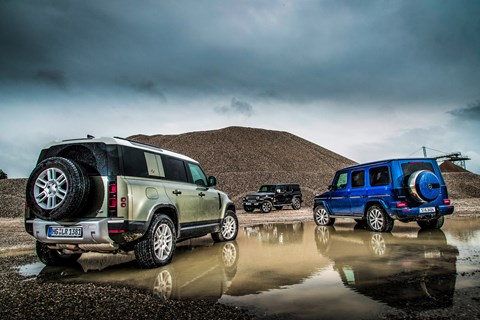
Defender vs Wrangler vs G-Class: the verdict
Land Rover Defender
★★★★★
Mercedes G-Class
★★★★
Jeep Wrangler
★★★★
Check out more CAR comparison tests here